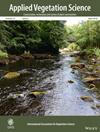Nontarget Plant Community and Biomass Responses in Northern Mixed Grassland Treated With Indaziflam for Invasive Annual Brome Control
Abstract
Aims
To understand how northern temperate grassland vegetation responds to indaziflam herbicide treatment used to control invasive annual bromegrass, we studied the initial and longer-term effects of indaziflam on plant species composition, richness, diversity, and biomass. We additionally assessed the influence of indaziflam on the recruitment of perennial grasses and forbs from the seedbank, and root and shoot biomass of young perennial grass plants.
Location
Dry Mixed Grassland of Alberta, Canada.
Methods
Plant biomass and cover composition were monitored over 4 years after indaziflam application in fall and spring at concentrations of 0, 37.5, 75, and 150 g ai ha−1 across two field sites, with four replication blocks for each concentration. Seedling emergence was assessed in the greenhouse using soil cores from fall plots two seasons after treatment. Root and shoot biomass of greenhouse-cultivated perennial grasses treated with indaziflam at 2 months age were quantified 2 months later.
Results
Indaziflam did not affect the cover, richness, or diversity of non-brome plant species until the fourth year after treatment. In the fourth year, indaziflam reduced plant richness and diversity and affected the cover of the three most abundant grasses but not the cover of the three most abundant forbs. Total shoot biomass decreased in the second year, increased in the third, and stabilized by the fourth year following indaziflam treatment. Perennial grass biomass either increased or remained the same but did not decline under any indaziflam treatment in any year. Forb biomass was not affected. In the greenhouse, indaziflam-treated soil had reduced seedling emergence of forbs but not perennial grasses, and indaziflam applied at 2 months of age reduced root and shoot biomass of four-month-old perennial grasses.
Conclusions
Our study provides an improved understanding of how indaziflam affects nontarget plant community composition and biomass within northern mixed grasslands where native vegetation is relatively intact but under increasing risk of invasion by annual bromegrasses. Land managers considering indaziflam application will have to weigh small reductions in diversity and subtle changes in perennial grass composition against the beneficial control of annual brome.


 求助内容:
求助内容: 应助结果提醒方式:
应助结果提醒方式:


